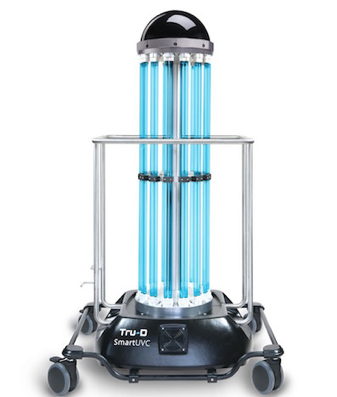 Cleanzine: your weekly cleaning and hygiene industry newsletter 10th July 2025 Issue no. 1170
Cleanzine: your weekly cleaning and hygiene industry newsletter 10th July 2025 Issue no. 1170
Your industry news - first
The original and best - for over 20 years!
We strongly recommend viewing Cleanzine full size in your web browser. Click our masthead above to visit our website version.
CDC-funded study underlines benefits of enhanced UVC disinfection in healthcare facilities
 A new, Centers for Disease Control & Prevention-funded analysis of the Benefits of Enhanced Terminal Room-Disinfection (BETR-D) shows that enhanced disinfection using UVC leads to a reduction of microbial contamination and a decrease in patient colonisation and infection.
A new, Centers for Disease Control & Prevention-funded analysis of the Benefits of Enhanced Terminal Room-Disinfection (BETR-D) shows that enhanced disinfection using UVC leads to a reduction of microbial contamination and a decrease in patient colonisation and infection.
The new substudy, 'Enhanced disinfection leads to reduction of microbial contamination and a decrease in patient colonisation and infection', was recently published in Infection Control & Hospital Epidemiology.
"This latest substudy is important because it supports the previous findings of the BETR-Disinfection study by showing that utilising enhanced disinfection leads to a decrease in microbial surface contamination that results in a decrease in hospital-acquired infections," says Alice Brewer, MPH, CIC, director of Clinical Affairs for Tru-D SmartUVC.
The BETR-D study was a pragmatic, prospective, multi-centre, cluster-randomised trial that evaluated four strategies for terminal room disinfection throughout nine hospitals between April 2012 and July 2014 with the goal of evaluating reduction of Acinetobacter, C. diff, MRSA and VRE.
This substudy performed microbiological analysis of randomly selected 'seed' rooms to determine the number of colony-forming units (CFUs) of the four target organisms that remained in the patient room following manual terminal room decontamination with liquid disinfectants alone - a widespread practice for disinfection of patient rooms.
"...to our knowledge, the BETR disinfection study and this analysis of the BETR disinfection study data are the first that quantitively describe the entire pathway whereby enhanced disinfection decreases microbial contamination, which in turn reduces patient colonisation and infection," the substudy states.
Tru-D SmartUVC was the only device chosen for the CDC-funded randomised clinical trial due to its ability to establish a baseline of disinfection with its Sensor360 technology. Results of the landmark BETR-D study proved that enhanced terminal room disinfection strategies using Tru-D, decreased risk of acquisition and infection of four major superbugs not only from patient to patient, but throughout an entire facility, hospital-wide.
The substudy authors concluded, that as a result of their cumulative findings, "...hospitals should use an enhanced terminal disinfection method for contact precaution patient rooms to reduce the risk of HAIs originating in the environment."
Alice Brewer says of the findings: "Tru-D is proud to be validated by more than 15 independent studies to show that it is capable of reducing infections hospital-wide.
"Using patented technology, Tru-D ensures significant pathogen reduction from one placement in the room, eliminating the threat of human error in the disinfection process."
Tru-D is brought into a room after the environmental services staff cleans using traditional methods. Operating from one placement and administering a single cycle of UVC light, Tru-D then destroys harmful pathogens that can remain behind such as C. diff, MRSA, MERS, VRE, Ebola and many more.
During the disinfection process, operators are free to complete other tasks such as cleaning rooms, changing linens or other duties before being notified via audio and/or text message that the room has been thoroughly disinfected.
25th October 2018







